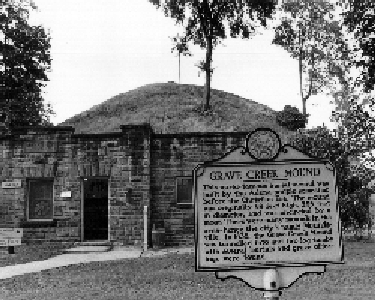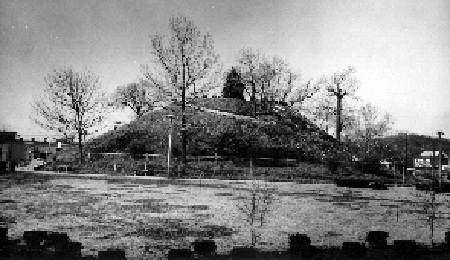

The Adena people were the first Native Americans to build ceremonial mounds. In other parts of the world, ceremonial burials had occurred much earlier. The Egyptian pyramids date to 2700 BCE; in England, stone chambers called barrows were used as early as 2000 BCE; between 1700 and 1400 BCE, keirgans were used in central Siberia; and the burial mounds of the Choo Dynasty in northern China date to 1000 BCE.
We know little about how or why the mounds were built. Historian Otis Rice suggests these early Americans "built mounds over the remains of chiefs, shamans, priests, and other honored dead." For their "common folk," the Adenas cremated the dead bodies, placing the remains in small log tombs on the surface of the ground. Virtually all of these graves have been destroyed by nature and later settlement. Therefore, the more substantial mounds are our only physical records of Adena burials.
Grave Creek Mound
The Grave Creek Mound in Moundsville (Marshall County) is
the largest conical type burial mound in the United States,
approched in size by only the Miamisburg, Ohio mound.  The mound, 62 feet high and 240 feet in diameter,
contains approximately 57,000 tons of dirt and originally stood
nearly 70 feet high. The digging of so much earth left a sizeable
moat or ditch surrounding the mound, no longer in existence. By
testing the soil, archaeologists estimate the mound was built
between 250 and 150 BCE by the Adena culture, which occupied the
area from about 1000 BCE to 200 CE. The mound and two forts were
the essential features of an Adena village in the shape of a
triangle. "The mound construction probably began with the death of
a very important person. There is no way to know who this person
was -- great warrior, chieftain or religious leader. We know that
25-30 years later another important personage died and his remains
were placed in an 8 by 12 foot vault on the top of the mound when
it was approximately 35 feet high. The natives then covered this
with dirt until the mound reached its maximum height."1
The mound, 62 feet high and 240 feet in diameter,
contains approximately 57,000 tons of dirt and originally stood
nearly 70 feet high. The digging of so much earth left a sizeable
moat or ditch surrounding the mound, no longer in existence. By
testing the soil, archaeologists estimate the mound was built
between 250 and 150 BCE by the Adena culture, which occupied the
area from about 1000 BCE to 200 CE. The mound and two forts were
the essential features of an Adena village in the shape of a
triangle. "The mound construction probably began with the death of
a very important person. There is no way to know who this person
was -- great warrior, chieftain or religious leader. We know that
25-30 years later another important personage died and his remains
were placed in an 8 by 12 foot vault on the top of the mound when
it was approximately 35 feet high. The natives then covered this
with dirt until the mound reached its maximum height."1
The first person of European descent to discover the mound was early settler Joseph Tomlinson, who literally stumbled off the top while hunting in 1770. In 1838, descendants Jesse and Abelard Tomlinson, and Thomas Briggs gutted the mound, destroying much of the archaeological evidence provided by the scientific study of other mounds. Tunneling from the side and top, the two men discovered a burial chamber in the center containing two skeletons and large amount of jewelry and another room with one skeleton and jewelry. Tomlinson opened the center chamber as a museum, charging 25 cents admission. Five years later, Henry Rowe Schoolcraft mapped the area. In 1909, the state acquired possession of the mound, placing it under the care of West Virginia Penitentiary warden M. S. White. In 1975, Dr. E. Thomas Hemmings of the West Virginia Geological and Economic Survey conducted the first scientific excavation of the area, locating among other items the previous existence of a moat. During the last two hundred years, the top of the mound has been home to a saloon, dance platform, and artillery pieces during the Civil War. Today, the state operates the Grave Creek Mound State Park and Delf Norona Museum and Culture Center, featuring numerous Native American artifacts from the mound and region.2
Criel Mound
The Criel Mound in South Charleston is the largest of
approximately fifty conical type mounds of the Adena culture in an
area west of Charleston extending to Institute.  The precise age of the Criel Mound is unknown,
but archaeologists believe it dates to the time of the Grave Creek
Mound in Moundsville, probably built between 250 and 150 BCE. It
was the burial ground for an Indian village located on the site of
the city of South Charleston some 2,000 years ago. It is unknown
when the village disappeared, although some have suggested it
remained until as late as 1650 CE In West Virginia, the 35-foot
high and 175-foot diameter Criel Mound is exceeded in size only by
the Grave Creek Mound.3
The precise age of the Criel Mound is unknown,
but archaeologists believe it dates to the time of the Grave Creek
Mound in Moundsville, probably built between 250 and 150 BCE. It
was the burial ground for an Indian village located on the site of
the city of South Charleston some 2,000 years ago. It is unknown
when the village disappeared, although some have suggested it
remained until as late as 1650 CE In West Virginia, the 35-foot
high and 175-foot diameter Criel Mound is exceeded in size only by
the Grave Creek Mound.3
The Criel Mound was first excavated by Professor P. W. Norris of the Smithsonian Institute in 1883 and 1884. Tunneling from the top down, the archaeologists discovered the following:
At the depth of 3 feet, in the center of the shaft, some human bones were discovered, doubtless parts of a skeleton said to have been dug up before or at the time of the construction of the judges' stand. At the depth of 4 feet, in a bed of hard earth composed of mixed clay and ashes, were two skeletons, both lying extended on their backs, heads south, and feet near the center of the shaft. Near the heads lay two celts, two stone hoes, one lance head, and two disks.4
As they dug to a depth of 31 feet, numerous other skeletons were found, including a burial vault containing the remains of eleven Native Americans thought to have been killed in battle. There was also evidence that some may have been buried alive. As was the custom, various jewelry and weapons were placed in the buried vaults. Today, all the artifacts and skeleton remains are maintained at the Smithsonian Institute in Washington, D.C.5
Notes
1. History of Marshall County West Virginia 1984 (Marshall County Historical Society, 1984), 6.
2. History of Marshall County West Virginia 1984, 6-7; Phil Conley and William Thomas Doherty, West Virginia History (Charleston: Education Foundation, Inc., 1974), 51-52.
3. Stephen B. Preston, "An Introduction to the Mound Builders and the Criel Mound, `D' Street, South Charleston," in J. Alfred Poe and Albert Giles, "The History of South Charleston, West Virginia, Volume I," (hereafter Preston, "Mound Builders"), 16, 18.
4. "Ancient Works Near Charleston," U. S. Bureau of Ethnology, Twelfth Annual Report, 1890-91 (Washington, D.C.), as quoted in Preston, "Mound Builders," 14.
5. Phil Conley and William Thomas Doherty, West Virginia History (Charleston: Education Foundation, Inc., 1974), 52-53; Otis K. Rice, West Virginia: A History (Lexington: The University Press of Kentucky, 1985), 5-6.